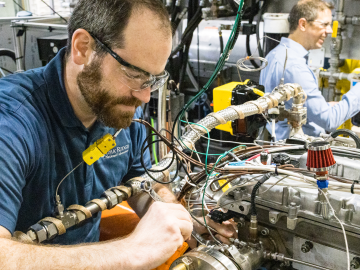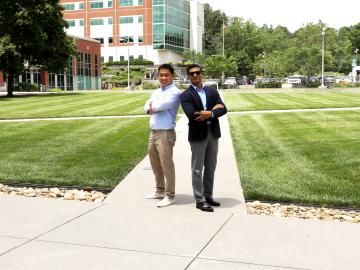
Filter News
Area of Research
- (-) Biology and Environment (54)
- (-) National Security (53)
- (-) Supercomputing (91)
- Advanced Manufacturing (22)
- Biology and Soft Matter (1)
- Building Technologies (1)
- Computational Biology (2)
- Computational Engineering (2)
- Computer Science (8)
- Electricity and Smart Grid (3)
- Energy Science (198)
- Fuel Cycle Science and Technology (1)
- Functional Materials for Energy (1)
- Fusion and Fission (8)
- Fusion Energy (2)
- Isotopes (1)
- Materials (51)
- Materials for Computing (10)
- Neutron Science (23)
- Nuclear Science and Technology (5)
- Quantum information Science (1)
- Sensors and Controls (1)
- Transportation Systems (2)
News Topics
- (-) 3-D Printing/Advanced Manufacturing (15)
- (-) Artificial Intelligence (50)
- (-) Grid (13)
- (-) Mercury (7)
- (-) National Security (36)
- (-) Summit (47)
- (-) Transportation (10)
- Advanced Reactors (3)
- Big Data (32)
- Bioenergy (51)
- Biology (77)
- Biomedical (28)
- Biotechnology (15)
- Buildings (6)
- Chemical Sciences (15)
- Clean Water (11)
- Composites (5)
- Computer Science (113)
- Coronavirus (24)
- Critical Materials (4)
- Cybersecurity (23)
- Energy Storage (12)
- Environment (106)
- Exascale Computing (28)
- Frontier (32)
- Fusion (3)
- High-Performance Computing (58)
- Hydropower (8)
- Isotopes (3)
- Machine Learning (28)
- Materials (25)
- Materials Science (23)
- Mathematics (5)
- Microscopy (16)
- Molten Salt (1)
- Nanotechnology (16)
- Neutron Science (17)
- Nuclear Energy (9)
- Partnerships (10)
- Physics (10)
- Polymers (4)
- Quantum Computing (20)
- Quantum Science (26)
- Security (15)
- Simulation (26)
- Software (1)
- Space Exploration (3)
Media Contacts

The Oak Ridge Leadership Computing Facility, a Department of Energy Office of Science user facility at ORNL, is pleased to announce a new allocation program for computing time on the IBM AC922 Summit supercomputer.

The Department of Energy’s Oak Ridge National Laboratory hosted its Smoky Mountains Computational Science and Engineering Conference for the first time in person since the COVID pandemic broke in 2020. The conference, which celebrated its 20th consecutive year, took place at the Crowne Plaza Hotel in downtown Knoxville, Tenn., in late August.

Tom Karnowski and Jordan Johnson of ORNL have been named chair and vice chair, respectively, of the East Tennessee section of the Institute of Electrical and Electronics Engineers, or IEEE.

Mike Huettel is a cyber technical professional. He also recently completed the 6-month Cyber Warfare Technician course for the United States Army, where he learned technical and tactical proficiency leadership in operations throughout the cyber domain.

Cody Lloyd became a nuclear engineer because of his interest in the Manhattan Project, the United States’ mission to advance nuclear science to end World War II. As a research associate in nuclear forensics at ORNL, Lloyd now teaches computers to interpret data from imagery of nuclear weapons tests from the 1950s and early 1960s, bringing his childhood fascination into his career

In the search for ways to fight methylmercury in global waterways, scientists at Oak Ridge National Laboratory discovered that some forms of phytoplankton are good at degrading the potent neurotoxin.

ORNL, the Department of Energy’s largest multidisciplinary laboratory, and Fairbanks Morse Defense, a portfolio company of Arcline Investment Management, have entered into a Memorandum of Understanding to collaborate on the development and integration of alternative fuel technologies aimed at reducing the marine engine’s reliance on fossil fuels.

ORNL hosted its fourth Artificial Intelligence for Robust Engineering and Science, or AIRES, workshop from April 18-20. Over 100 attendees from government, academia and industry convened to identify research challenges and investment areas, carving the future of the discipline.

Wildfires have shaped the environment for millennia, but they are increasing in frequency, range and intensity in response to a hotter climate. The phenomenon is being incorporated into high-resolution simulations of the Earth’s climate by scientists at the Department of Energy’s Oak Ridge National Laboratory, with a mission to better understand and predict environmental change.

When geoinformatics engineering researchers at the Department of Energy’s Oak Ridge National Laboratory wanted to better understand changes in land areas and points of interest around the world, they turned to the locals — their data, at least.


